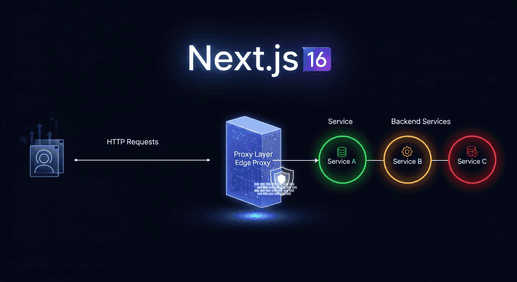Deploying Next.js on AWS: Why We Migrated from Amplify to ECS

When deploying Next.js applications on AWS, developers face a critical decision between two powerful but fundamentally different platforms: AWS Amplify and AWS ECS (Elastic Container Service). Both offer robust hosting solutions, yet they serve distinct use cases and present unique trade-offs. Understanding these differences is crucial for making an informed architectural decision that will impact your application's performance, scalability, and maintainability.
AWS Amplify: The Developer-First Platform
AWS Amplify represents the modern approach to application deployment, designed specifically for frontend and full-stack applications. As a fully managed service, Amplify abstracts away the complexities of infrastructure management, allowing developers to focus entirely on building features rather than managing servers. This platform excels particularly well with JAMstack applications and provides an remarkably streamlined deployment experience that can get applications from code to production in minutes.
The service shines brightest in its commitment to developer productivity, offering several key advantages:
- Zero Infrastructure Management: Developers never need to configure servers, containers, or load balancers
- Automatic Scaling: Responds to traffic spikes without manual intervention or pre-configuration
- Built-in CI/CD: Git-based deployment workflow with preview environments for every branch
- Global CDN: Every deployment automatically leverages CloudFront for worldwide content delivery
- SSL Certificates: Automatic HTTPS provisioning and management, even for custom domains
- Atomic Deployments: Zero downtime deployments with instant rollback capabilities
However, this simplicity comes with inherent limitations that become apparent as applications grow in complexity:
- Limited Runtime Control: Reduced ability to customize the execution environment for specific requirements
- Cold Start Latency: Server-side rendering may experience delays during Lambda function initialization
- Build Time Constraints: 15-minute timeout limit can restrict larger applications with complex build pipelines
- Cache Isolation: Lambda functions cannot share cache between instances, creating performance bottlenecks
The Critical Cache Isolation Problem
Perhaps the most significant limitation of AWS Amplify's architecture lies in its inability to share cache between Lambda function instances. This architectural constraint creates a fundamental problem for applications that rely on server-side caching strategies. Each Lambda execution begins with a fresh container, meaning the Next.js build cache stored in the .next/cache directory cannot persist or be shared between different requests.
In my latest project, our Next.js application was configured to fetch content from Strapi and cache it for reuse across multiple users. While this seems straightforward, Amplify's Lambda-based architecture made it impossible to implement effectively. Since AWS Lambda functions don't run continuously and are destroyed after periods of inactivity, any cached content is lost when the function terminates. New requests trigger fresh Lambda instances, which must make new requests to Strapi since they cannot access previously cached data.
The result was a cascading performance problem where our Strapi instance became severely overloaded with redundant requests that should have been served from cache. This not only degraded application performance but also significantly increased our infrastructure costs due to the needs of increasing resources for Strapi machine, excessive API calls and database queries that could have been avoided with proper caching.
This limitation became the primary driver for looking for a better solution and migrating from Amplify. After weeks of trying various workarounds and caching strategies within Amplify's constraints, it became evident that the solution required a fundamentally different architectural approach. That's when we turned our attention to AWS ECS.
AWS ECS: The Container Orchestration Powerhouse
AWS ECS represents a completely different philosophical approach to application deployment. As a fully managed container orchestration service, ECS provides complete control over your application's runtime environment while still handling the underlying infrastructure management. This platform is particularly well-suited for applications requiring custom configurations, microservices architectures, or specific scaling requirements that go beyond what serverless platforms can offer.
The control that ECS provides is its greatest strength, delivering several significant advantages:
- Complete Runtime Control: Customize every aspect from operating system to specific library dependencies
- Fine-grained Scaling: Implement custom scaling policies based on CPU, memory, or application-specific metrics
- AWS Integration: Seamless access to the entire AWS ecosystem without platform constraints
- Consistent Performance: Long-lived containers eliminate cold starts and provide predictable response times
- Advanced Networking: VPC integration, custom security groups, and sophisticated load balancing strategies
Yet this power comes with increased complexity that teams must carefully consider:
- Infrastructure Knowledge Required: Demands container orchestration expertise that may not exist in all teams
- Complex Initial Setup: Significantly more configuration compared to Amplify's one-click deployment
- Ongoing Maintenance: Cluster management, task definitions, and capacity planning add operational overhead
- Custom Monitoring: Teams must implement their own logging, metrics, and alerting systems
Moving to AWS ECS represented a fundamental shift in our deployment strategy. Unlike Amplify's serverless approach, ECS runs applications in long-lived containers that can maintain state, share cache between requests, and provide the consistent performance our application demanded. This architectural difference immediately solved our caching problems—containers persist for hours or even days, allowing Next.js to build and maintain its cache across multiple requests. The shared cache that was impossible with Lambda became effortless with ECS.
Making the Strategic Decision
The choice between Amplify and ECS should be driven by your specific application requirements and team capabilities rather than general preferences. Amplify excels when you need rapid prototyping capabilities for MVPs and demo applications where time-to-market is critical. Small teams with limited DevOps expertise will find Amplify's managed approach removes significant operational burden while still providing professional-grade infrastructure.
Simple applications that utilize standard Next.js features without complex caching requirements or custom runtime needs are ideal candidates for Amplify. The platform's git-based workflow creates an excellent developer experience for teams that want automatic deployments triggered by repository changes. Applications that need global distribution benefit from Amplify's automatic CDN configuration without requiring additional setup or expertise.
However, you should avoid Amplify if your application relies heavily on server-side caching strategies, as the Lambda-based architecture fundamentally cannot support shared state between requests. Applications with high-frequency API routes that benefit from persistent connections or shared memory will face significant performance constraints. If performance consistency is critical to your user experience, the potential for cold starts in Amplify may be unacceptable. Similarly, applications requiring fine-grained control over caching strategies will find Amplify's managed approach too restrictive.
ECS becomes the preferred choice when you have custom requirements that demand specific runtime configurations or dependencies not supported by managed platforms. Microservices architectures with multiple services requiring complex communication patterns benefit from ECS's networking flexibility and container orchestration capabilities. Applications demanding high performance with consistent, predictable response times will find ECS's always-on container model superior to serverless alternatives.
The shared caching capabilities that ECS enables make it particularly beneficial for applications with expensive computations that can be cached and reused across requests. High-traffic applications requiring consistent performance characteristics will appreciate the elimination of cold starts and the ability to maintain persistent connections and in-memory state. Complex applications with multiple interconnected services can leverage ECS's container orchestration to manage sophisticated deployment patterns and service communication.
Enterprise applications often gravitate toward ECS due to its comprehensive security and compliance capabilities, along with the ability to integrate with existing containerized services in hybrid architectures. Teams with existing container expertise will find ECS's model familiar and powerful, allowing them to leverage their existing knowledge and tooling.
Conclusion: Aligning Technology with Requirements
The beauty of AWS's ecosystem lies in its evolutionary path. Many applications (including mine) begin their journey on Amplify, taking advantage of its rapid deployment capabilities and managed infrastructure to achieve fast time-to-market. As applications grow in complexity and requirements become more sophisticated, migrating to ECS becomes a natural progression rather than a fundamental architecture change.
Both platforms represent excellent choices within their respective domains, and neither is inherently superior to the other. The key is understanding your current requirements, anticipated growth patterns, and team capabilities. Start with the platform that best matches your immediate needs while keeping an eye on future requirements that might necessitate a different approach.
Remember that the best architectural decision is one that aligns with your team's expertise, project requirements, and long-term strategic goals. Both Amplify and ECS will serve your Next.js applications exceptionally well when chosen appropriately for your specific context and requirements.





